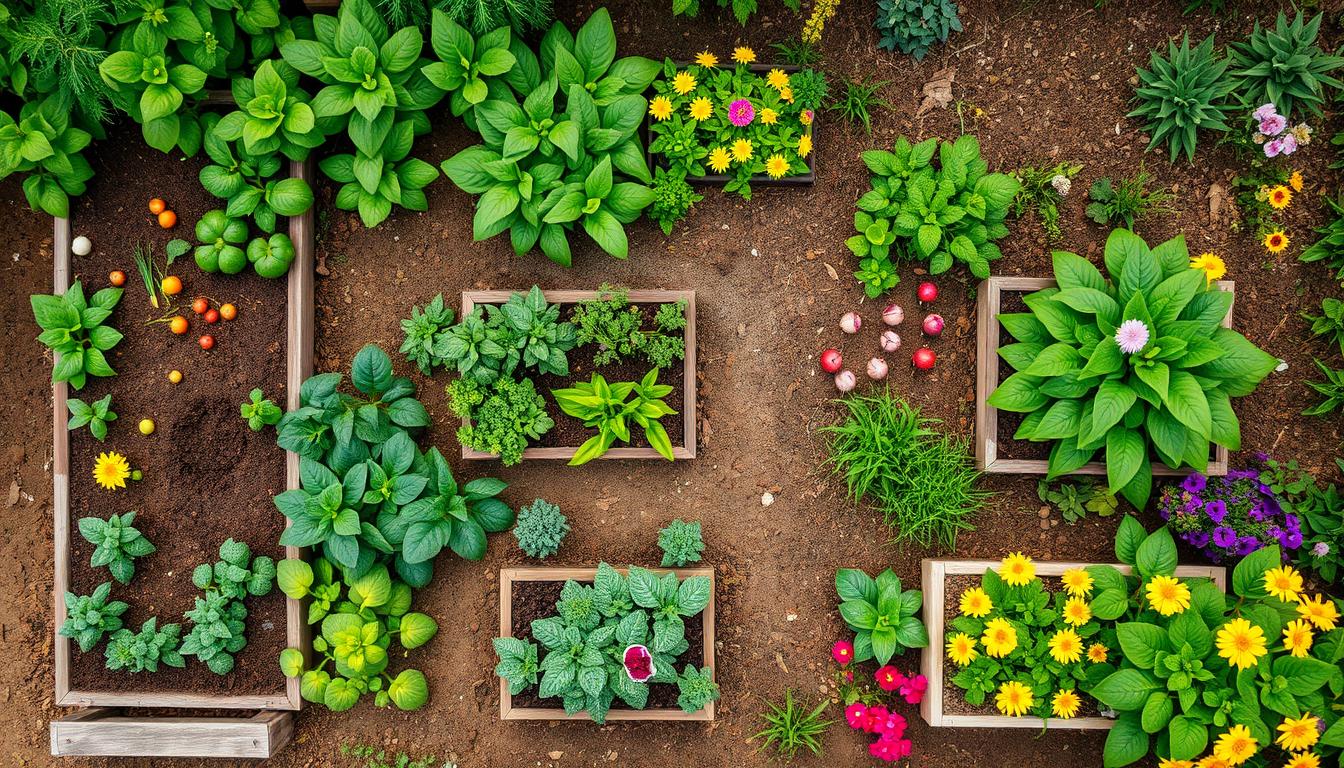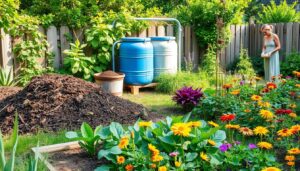When I first started gardening, I felt a deep connection to the earth. I wanted to grow my own food. It’s fulfilling to see a seed grow into a vibrant plant.
Organic gardening lets me grow healthy, chemical-free food. It also helps our planet. Every harvest is exciting because I’m helping the environment.
If you’re new to gardening or experienced, join me. We’ll grow an organic garden together. Every plant is a story of hope and resilience.
Key Takeaways
- Organic gardening requires at least 6 to 8 hours of sunlight each day for optimal plant growth.
- Leafy greens can thrive with as little as 3 hours of sunlight.
- Soil enrichment is essential; use a mix of organic soil products for best results.
- Water wisely using targeted irrigation methods to avoid over-watering.
- Maintaining garden hygiene, such as removing diseased plants, is crucial for health.
Understanding Organic Gardening
Organic gardening means growing plants without using synthetic chemicals. It uses natural methods to improve soil health and support a balanced ecosystem. I’ve found many benefits in organic gardening.
What is Organic Gardening?
Organic gardening focuses on using eco-friendly practices. It avoids artificial pesticides and fertilizers. Instead, I use:
- Cultural practices: rotating crops and using resistant plant varieties.
- Biological controls: harnessing nature’s predators, including over a hundred families of beneficial insects, spiders, and mites.
- Mechanical methods: using physical barriers and proper planting times to defend against pests.
This way, I keep my garden safe for people, pets, and the planet.
Benefits of Organic Gardening
Organic gardening has many advantages. For me, it means:
- Improved soil health: Using compost and animal manures makes soil better.
- Increased plant disease resistance: Healthy soil helps plants fight off diseases.
- Better flavor and nutrition: My homegrown food tastes better and is more nutritious.
- Environmental stewardship: It helps keep the ecosystem healthy by avoiding harmful chemicals.
Organic gardening lets me enjoy my hard work while caring for the environment. It’s rewarding to be part of a sustainable movement.
Selecting the Right Location for Your Organic Garden
Finding the perfect spot for your organic garden is key to success. A good location can greatly affect your plants’ health and how much you harvest. It’s important to think about sunlight and how easy it is to get to your garden.
Sunlight Requirements
Most veggies need 6 to 10 hours of direct sunlight a day. This helps them grow strong and produce well. Leafy greens like spinach and lettuce do okay in some shade but love the sun.
Make sure your garden isn’t too shaded by trees. Tree roots can take away important nutrients and block sunlight.
Accessibility and Water Source
It’s also important to pick a spot that’s easy to get to. Having your garden near a water source makes watering easier. This keeps your plants happy and healthy.
Think about how you’ll move around your garden. This makes it easier to care for your plants and pick your food. If you like cooking with fresh herbs, put your garden near your kitchen.
| Factor | Ideal Conditions | Notes |
|---|---|---|
| Sunlight | 6-10 hours per day | Avoid shaded areas |
| Water Access | Near a reliable water source | Facilitates easy watering |
| Soil Type | Well-drained | Prevents waterlogging |
| Space | At least 3 feet away from tree roots | Prevents nutrient depletion |
By thinking about these things, you can make a great organic garden. This garden will use good practices and grow your veggies well.
Essential Soil Management Techniques
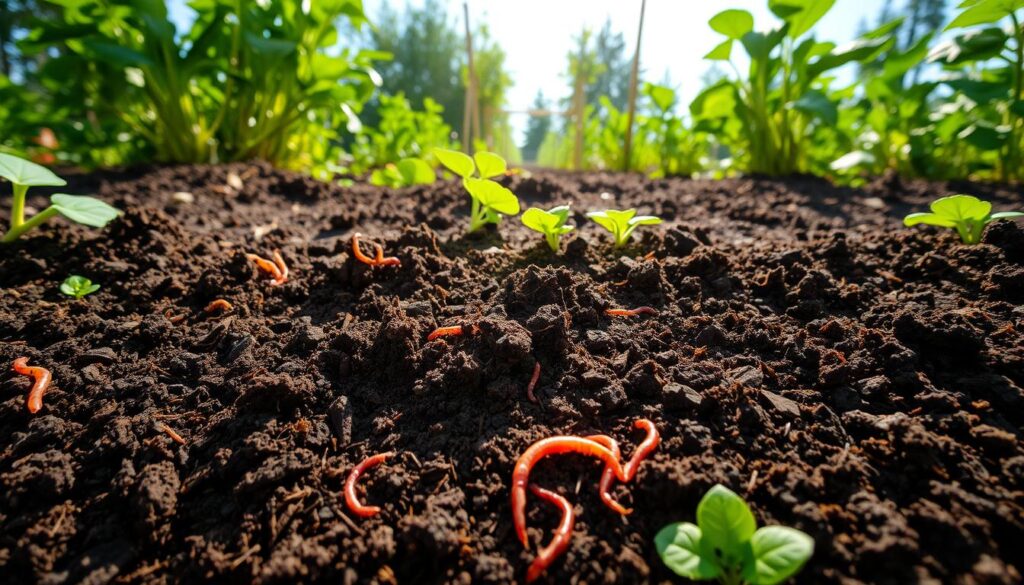
Good organic soil management is key to a healthy garden. It makes plants grow well and strong. By testing the soil, composting, and ensuring good drainage, I can make my garden thrive.
Soil Testing for Nutrient Levels
Soil testing helps me know what nutrients my garden needs. Most veggies like a pH of 6.5 to 7, while fruits prefer 6 to 6.5. Soil testing kits show me if my soil is too acidic or alkaline.
I test my soil every three to five years. This keeps my garden healthy and lets me adjust my care as needed.
Creating Nutrient-Rich Soil with Compost
Composting makes my soil better by adding nutrients. Adding 5-10% compost to my soil helps plants grow. Good compost has the right mix of nitrogen, phosphorus, and potassium.
Using green manures like winter rye also helps. They improve soil structure and bring in beneficial microbes. These microbes are important for plant health.
Importance of Well-Draining Soil
Soil that drains well is essential for a healthy garden. It helps plants grow strong roots and prevents waterlogged soil. The right mix of sand, silt, and clay makes soil drain well.
I aim for a mix of 19% sand, 20% silt, and 61% clay. This loam texture is great for working with. By focusing on drainage, I help my garden grow sustainably.
| Soil Quality Aspect | Notes |
|---|---|
| pH Range for Vegetables | 6.5 – 7 |
| pH Range for Fruits | 6 – 6.5 |
| Ideal Compost Nutrient Ratios | Nitrogen: 1.5 – 3.5%, Phosphorus: 0.5 – 1%, Potassium: 1 – 2% |
| Organic Matter Percentage | 5 – 10% in soil |
| Soil Texture Ratio | 19% Sand, 20% Silt, 61% Clay |
| Testing Frequency | Every three to five years |
Choosing Plants for Your Organic Garden
Choosing the right plants for my organic garden is key to a thriving ecosystem. I pick native plants that do well in my local climate. These plants need less care, which helps my garden and the environment.
Native Plants and Climate Considerations
Native plants are crucial for a sustainable garden. They fit well with local soil and weather, needing less water and no chemicals. For example, wildflowers brighten my garden and attract pollinators, boosting biodiversity.
Using Organic Seeds for Healthy Growth
Using organic seeds helps me avoid harmful chemicals found in conventional gardening. Growing plants from seeds promotes a natural process. This leads to stronger, healthier plants, as they adapt to local conditions from the start. It lets me try different plants that fit my area.
Incorporating Heirloom Varieties
I enjoy adding heirloom seeds to my garden for their unique flavors and history. These plants add diversity and connect me to gardening traditions. They often have exceptional tastes that make my organic produce even more special.
Watering Wisely in Your Organic Garden

Watering is key in my organic garden. It helps plants stay healthy and saves water, which is important as climate change makes water scarcer. By watering wisely, I help my plants and the planet.
Understanding Soil Moisture Levels
Soil moisture is vital for plants. I check the soil by feeling it with my finger. I only water when it’s really needed. This stops plants from getting too wet.
Plants like lettuce, pumpkins, and squashes need regular water. Young trees and shrubs need water weekly from March to October to grow strong roots.
Best Practices for Watering Techniques
Using eco-friendly methods in watering helps my garden and the environment. Here are some of my top tips:
- Water in the morning or evening to avoid losing water to evaporation.
- Use drip irrigation or soaker hoses to water plants efficiently and save water.
- Place a bucket under hanging baskets to catch extra water and use it wisely.
- Be careful with terracotta pots because they need more water due to their porosity.
- Use organic mulch to keep the soil moist, prevent erosion, and stop weeds.
- Choose plants like lavender, rosemary, and yucca that use less water.
By using these methods, my garden grows well while saving water. I also protect my plants from drying winds by selecting the right plants and using barriers.
| Watering Technique | Benefits | Best Timing |
|---|---|---|
| Drip Irrigation | Efficient water delivery to roots | Anytime, ideal for larger gardens |
| Early Morning Watering | Reduces evaporation, healthier plants | 6 AM – 9 AM |
| Mulching | Conserves moisture, prevents weeds | Throughout the growing season |
| Rainwater Collection | Conserves tap water resources | Anytime during rainfall |
These careful watering practices help my garden grow while being kind to the environment.
Feeding Your Plants with Organic Fertilizers
Keeping your plants healthy means giving them the right food. Organic fertilizers are key to this. They help your soil and plants grow strong.
Types of Organic Fertilizers
There are many organic fertilizers to choose from. They give your plants the nutrients they need. Here are some popular ones:
- All-purpose granular fertilizer
- Bone meal
- Rock phosphate
- Blood meal
- Fish emulsion
- Seaweed fertilizer
- Potassium sources
Liquid fertilizers like kelp and fish are great. They give nutrients directly to your plants. Studies show that giving plants small amounts often is better than big amounts less often.
Homemade Nutrients for Your Garden
Making your own nutrients is rewarding. Compost is a top choice. It’s full of nutrients and good for the soil.
Using organic fertilizers from natural sources is best. They should be applied often and in small amounts. For example, sea minerals can be used at 2-4 gallons per acre a year. Spread it out monthly for best results.
Adding compost and mulches to your soil helps. It makes nutrients easier for plants to get. But, don’t overdo it. Soil tests can tell you if your soil needs more.
The best garden uses compost and quality soil with organic fertilizers. This way, your plants will grow well.
Mulching for Healthy Growth
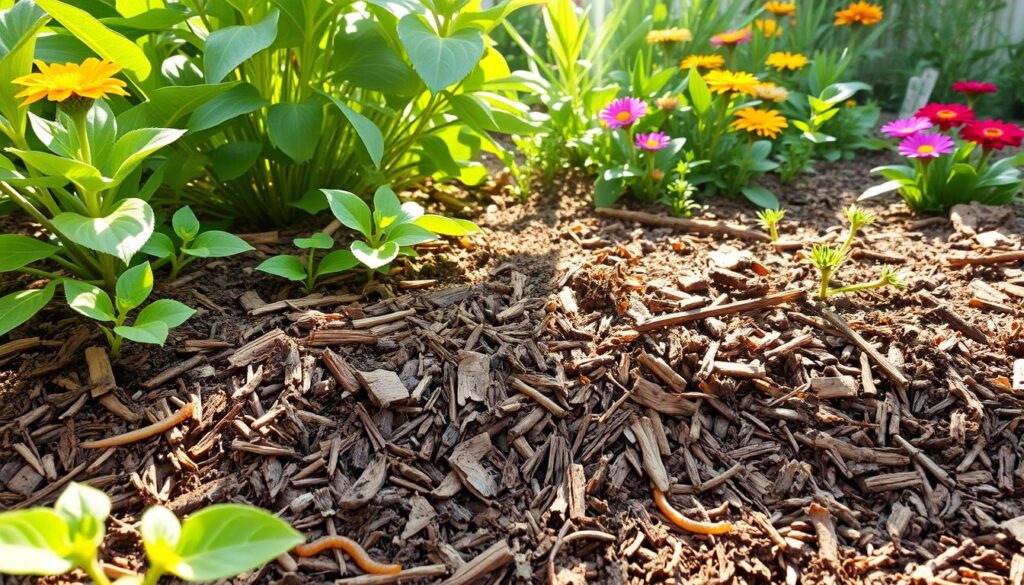
Using organic mulch in my garden has been incredibly rewarding. It enriches the soil, keeps moisture in, and fights weeds. This keeps my plants healthy. Learning about organic mulch and trying different types has made my gardening more sustainable.
Benefits of Organic Mulch
Organic mulch brings many benefits to my garden. Here are some key advantages:
- Moisture Conservation: Mulch keeps water in the soil, helping my plants grow well.
- Weed Suppression: A good layer of mulch cuts weed growth by 80%, letting my veggies grow better.
- Nutrient Addition: As mulch breaks down, it adds nutrients to the soil, making it healthier.
- Temperature Regulation: Mulch keeps soil temperature stable, protecting roots from extreme weather.
Types of Mulch to Use
Choosing the right mulch is key for new gardeners. Here are some eco-friendly options:
| Type of Mulch | Benefits | Considerations |
|---|---|---|
| Grass Clippings | Provides nitrogen boost, breaks down quickly. | May contain seeds that encourage weeds. |
| Straw | Effective for moisture retention and weed suppression. | Can introduce unwanted seeds; choose seed-free options. |
| Wood Chips | Long-lasting, aesthetically pleasing. | Requires nitrogen for decomposition, may compete with plants. |
| Shredded Leaves | Prevents weed seeding during dormant seasons. | Should be shredded for best results. |
| Compost | Adds nutrients and organic matter. | Best when applied in a thick layer. |
Trying different organic mulches has really improved my garden. These eco-friendly practices help my plants and support a healthy ecosystem.
Pest Management in Organic Gardening
Pest management is key in organic gardening. I’ve found that using organic pest control keeps my garden healthy. It also helps create a balanced ecosystem. By using natural methods, I protect my plants and encourage beneficial insects.
Natural Pest Control Methods
Effective natural pest control uses a mix of methods to keep pests away. I’ve seen that using organic solutions slowly builds my garden’s resistance. Here are some methods I’ve found to work well:
- Spinosad: Targets pests like caterpillars and beetles, causing them to die.
- B.T. (Bacillus thuringiensis): Kills larva-stage insects, offering a targeted approach.
- Diatomaceous earth (DE): A powder that dehydrates hard-shelled insects.
- Neem oil: Repels and suppresses pests, keeping them from eating my plants.
- Pyrethrin: Derived from chrysanthemum flowers, it quickly kills pests by damaging their nervous system.
Using these methods reduces the risks of synthetic chemicals. It also makes gardening more enjoyable as I see the natural balance work.
Beneficial Insects in the Garden
Adding beneficial insects to my garden has changed the game for organic pest control. These insects help control pests by eating them. Here are some beneficial insects I encourage:
- Ladybugs: Eat aphids and other soft-bodied insects.
- Lacewings: Their larvae eat aphids and caterpillar larvae.
- Parasitic wasps: Lay eggs inside pest larvae, controlling their numbers.
Keeping a diverse ecosystem is important. Chemical sprays can harm these beneficial insects, leading to more pests. Practices like companion planting help these insects and manage pests naturally. Organic gardening takes patience and observation, but the rewards are worth it.
| Pest Control Method | Target Pests | Application Method |
|---|---|---|
| Spinosad | Caterpillars, Beetles | Spray |
| B.T. | Lava stage insects | Soil or foliage |
| Diatomaceous Earth | Hard-shelled insects | Dust |
| Neem Oil | Various insects | Foliar spray |
| Pyrethrin | Multiple insects | Application on plants |
The mix of natural pest control and beneficial insects has greatly improved my garden. It’s fulfilling to create a thriving organic garden through careful pest management.
Crop Rotation for Soil Health
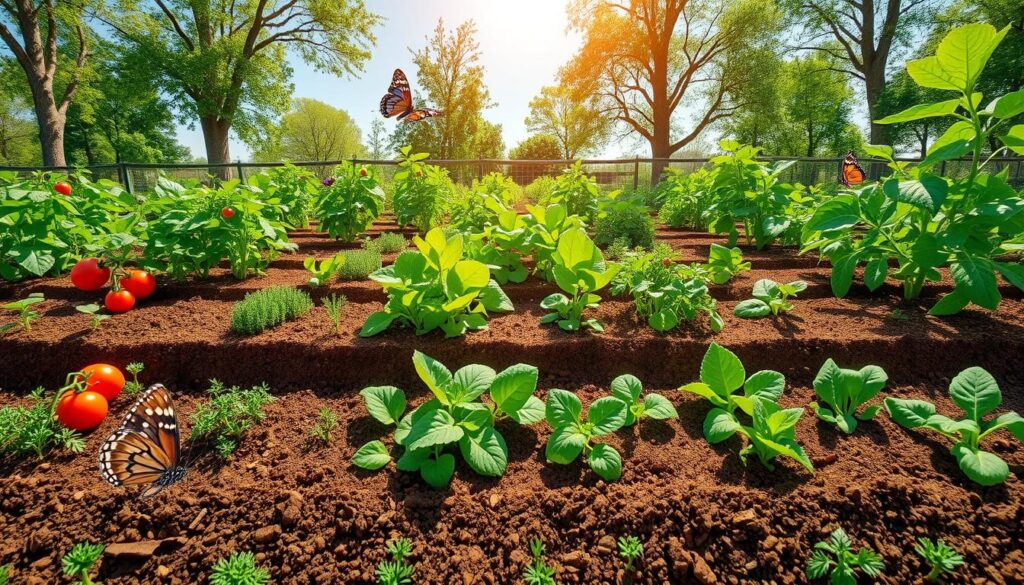
In my journey with organic vegetable gardening, I’ve learned that crop rotation is crucial. It involves changing what I plant in different areas each year. This helps reduce pests and diseases, making my garden healthier and more productive.
What is Crop Rotation?
Crop rotation means changing what I plant in my garden from season to season. It breaks the cycle of soil-borne diseases and pests. By planting different crops, I manage soil fertility better. For example, legumes like peas and beans fix nitrogen, enriching the soil.
Types of Crop Rotations to Consider
There are a few effective crop rotation methods I find useful:
- Harvest Group Method: Grouping plants like root, fruit, and leafy crops helps manage nutrients.
- Botanical Family Grouping: Rotating within families, like tomatoes and beans, prevents soil depletion and boosts biodiversity.
- Feeder Balancing: Alternating between heavy and light feeders keeps soil nutrient levels balanced.
Keeping a garden log or map is essential for me. It helps me avoid planting the same crop in the same spot too often. This practice not only improves soil health but also lets me try different companion planting and sequences.
Crop rotation has a long history, dating back to Ancient Rome and Medieval England. Today, it’s still a key part of sustainable practices for organic farmers.
Maintaining a Clean and Healthy Garden
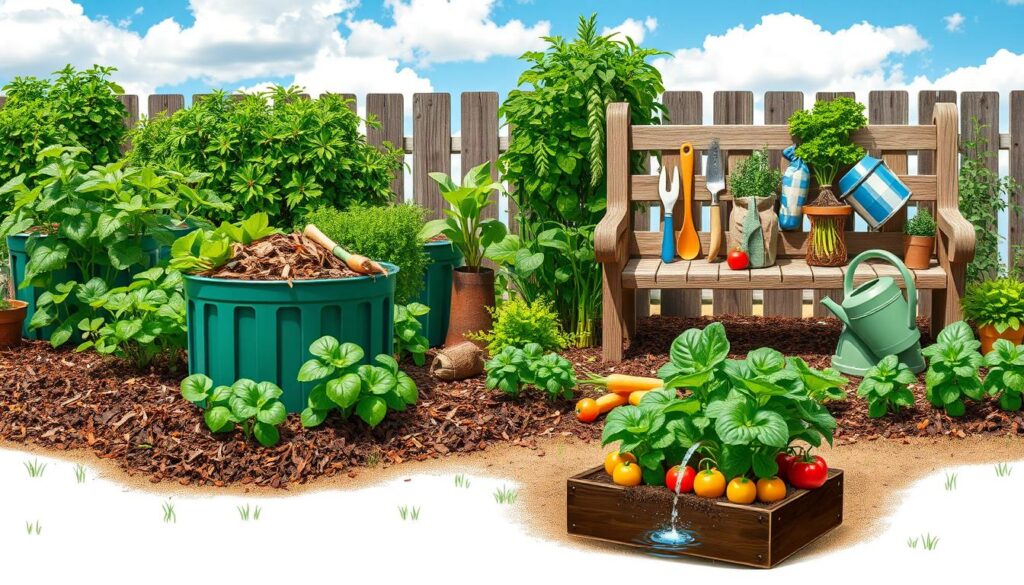
To excel in organic gardening, garden hygiene is key. Keeping my garden clean prevents disease and pests. This way, my plants grow well without chemicals, making farming chemical-free.
Garden Hygiene Practices
Checking my plants regularly is a must. I look for any signs of illness that need quick action. If I find a sick plant, I remove and dispose of it to stop diseases from spreading.
Here are some tips I use:
- Inspect leaves and stems for any unusual spots or discoloration.
- Clean gardening tools after each use to avoid cross-contamination.
- Limit the introduction of new plants; always quarantine them if possible.
Disposing of Diseased Plants
Proper disposal is crucial for my garden’s success. Here’s what I do with diseased plants:
- Remove diseased plants from the garden promptly.
- Do not compost infected plants to avoid spreading pathogens.
- Bag up the removed plants and dispose of them in the trash or a designated waste area.
Following these steps improves my garden’s hygiene and health. It makes my organic gardening better and supports sustainability.
Harvesting: Enjoying Your Organic Produce
Harvesting your organic produce is the best part of gardening. Knowing when to pick your crops is important. Things like how long it takes for them to grow, the weather, and the soil’s health all matter. For example, tomatoes should be picked when they’re ripe for the best taste.
It’s also important to know how to store your vegetables. This helps keep them fresh for a longer time.
When to Harvest Different Crops
Harvest times vary for different reasons. Seed packets can give you a good starting point, but remember, local weather can change things. Look for signs like size, color, and texture to know when to pick. Checking on your plants regularly is key to getting the best results.
Here are some basic guidelines for different crops:
| Vegetable/Fruit | Signs of Ripeness | Typical Harvest Time |
|---|---|---|
| Tomatoes | Fully colored and slightly soft | 70-90 days after planting |
| Carrots | Diameter of an inch or more | 60-80 days after planting |
| Peppers | Fully colored and firm | 60-90 days after planting |
| Spinach | Leaves are vibrant and tender | 30-45 days after planting |
| Swiss Chard | Leaves are large and colorful | 50-60 days after planting |
Tips for Storing and Preserving Your Harvest
After harvesting, it’s important to store your vegetables well. This helps keep them fresh for longer. Here are some ways to store your food:
- Canning: Great for long-term preservation, especially for tomatoes and fruits.
- Freezing: Retains nutrients well for vegetables like spinach and carrots.
- Drying: Ideal for herbs and fruits, providing a concentrated flavor.
- Refrigerating: Keeps delicate produce, such as berries, fresh for longer.
When harvesting, use gloves and the right tools to protect your crops. Paying attention to your plants’ health and picking them at the right time is crucial. This way, you can enjoy your hard work and the benefits of gardening.
Conclusion
Starting my organic gardening journey has changed me in amazing ways. I love growing plants and making my garden healthier. This way, I get fresh, chemical-free food and help the environment too.
Learning about composting and natural pest control has been a big lesson. It shows me how to live in harmony with nature. Plus, it’s easy to start, whether I’m using a small patio or gardening with my family. Online resources also help a lot, making it even more fun.
My experiences with organic gardening show how important it is to think carefully. From choosing organic seeds to knowing what each plant needs. With a bit of planning, patience, and effort, my city space has turned into a lush, organic garden.
FAQ
What is organic gardening?
Organic gardening means growing plants without synthetic fertilizers, pesticides, or herbicides. It uses natural methods like composting and crop rotation. This way, I can grow healthy, chemical-free foods and support biodiversity.
What are the benefits of organic gardening?
Organic gardening improves soil health and reduces chemical runoff. It also boosts biodiversity and makes homegrown produce taste better and be more nutritious. This approach supports a healthier ecosystem and promotes environmental balance.
How do I choose the right location for my organic garden?
Picking the right spot for your garden is key. Most fruiting plants need 6-8 hours of sunlight a day. Also, make sure the area is easy to water and not too close to big trees that can take away soil nutrients.
What should I do to manage soil health?
To manage soil well, test it for nutrients and pH. Adding organic matter like compost helps improve soil structure and fertility. Also, make sure the soil drains well to support strong roots.
How do I select plants for my organic garden?
Choose plants that are native to your area and need less care. Use organic seeds to avoid chemicals. Adding heirloom varieties can make your garden more diverse and flavorful.
How often should I water my organic garden?
Water based on how wet the soil is. Check by sticking your finger in it. Water only when it’s dry. Water at the base of plants and use drip irrigation for efficient watering.
What types of organic fertilizers should I use?
Use organic fertilizers like compost, manure, and special products. Homemade nutrients from kitchen scraps or compost tea are great for plants like tomatoes.
Why is mulching important in an organic garden?
Mulch keeps moisture in, controls temperature, and stops weeds. Use straw, grass clippings, or shredded leaves. They break down to enrich the soil over time.
How can I manage pests organically?
Use natural pest control like companion planting and introducing beneficial insects. Homemade insect repellents also work. Regular checks help catch problems early.
What is crop rotation and why is it important?
Crop rotation means changing what you grow in different parts of the garden each year. It keeps the soil healthy by preventing nutrient loss and pest buildup. This makes your garden more productive and diverse.
How do I maintain cleanliness in my organic garden?
Keep your garden clean by checking plants for illness and removing sick ones. Clean tools after use. This stops diseases and keeps your garden healthy.
When is the best time to harvest my crops?
Harvest times vary by crop. Tomatoes are best when fully ripe. Proper storage and preservation, like canning or freezing, let you enjoy your produce all year.
Source Links
- Organic Gardening for Beginners | How to Start a Garden
- Organic Gardening Basics: How to Start an Organic Garden
- Growing an Organic Garden – The Fundamentals
- Understanding Organic Gardening | Piedmont Master Gardeners
- What is Organic Gardening?
- Choosing the Right Location for Your Vegetable Garden : Newsroom
- Beginning Vegetable Garden Basics: Site Selection and Soil Preparation
- Garden Organic | Managing your soil
- Organic Gardening: Soil Management
- Soil Management in Home Gardens and Landscapes
- Garden Organic | Choosing your plants
- Garden Organic | Watering guide
- Water Wise Gardening | Milorganite
- Organic Garden Fertilizer – Fertilize Often Or Annually?
- Organic Fertilizer Options – The Beginner’s Garden
- A Comprehensive Guide to Using Mulch in a Vegetable Garden
- 7 Organic Mulches for the Vegetable Garden – Fine Gardening
- The Best Mulch for Your Vegetable Garden • The Prairie Homestead
- Organic Garden Pest Control
- Pest Control without Pesticides for a Healthy Organic Garden – The Beginner’s Garden
- Crop Rotation in the Garden – Maine Organic Farmers and Gardeners
- The Importance of Crop Rotation for a Healthy Organic Garden
- Grow An Organic Garden
- 8 Steps to Keeping a Healthy Garden – Bully Tools, Inc.
- Harvesting: Get the Most from the Garden
- 7 Steps to Starting and Enjoying an Organic Garden | Organic Voices
- Harvesting from My Vegetable Greenhouse – The Martha Stewart Blog
- Organic Garden: A Journey towards Sustainable Living
- Organic Gardening for Beginners [Full Guide]
- Organic Gardening Tips: Growing and Maintaining a Veggie Garden

